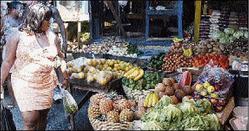
Rosalee Brown
Food safety, at home or in commercial establishments, is an area which cannot be overemphasised as it has implications for people's health.
Let us focus on the cleaning of the foods that we buy in the open market, green groceries and supermarkets. For those of us who shop at the open market, we know the advantages, that is, fresher produce, a greater variety and the ability to exercise our bargaining skills.
But, the open market is most times not a pretty sight, and you may often ask yourselves, 'what am I doing buying food in such an environment?' Very often, just a few feet away are piles of garbage that has not been removed for days, stagnant water, flies, and animals rummaging for food.
Many people refuse to subject themselves to such indignity and purchase from vendors who shop at the same place, then take it to a location which is a little bit more tolerable but 'for a price'.
There is a saying in Jamaica, 'Wha eye no se, heart no leap' and so, once we do not see the condition in which our food is bought, all is presumed well. However, we have very clear public health standards in this country, but very often there is 'a disconnect' between laws and practice.
Maybe as consumers we have become complacent with what we consider normal (without realising it) and we have settled for less. Many of these conditions in our markets, if we were to step away and view them maybe in another country, we would turn up our noses and ask, 'Why do people shop in such places?'
System of cleaning
It is generally good practice to have a system for cleaning foods.
Have a rough brush for cleaning ground provisions, which are often sold with a large amount of soil adhering to them. Remove excess earth and scrub clean and dry before storing with other foods. Never peel food with earth on them and then attempt to wash it away from the exposed food surface, as the earth can be a source of contamination. The earth on the food can harbour the microorganisms for some food-borne infections and even worm and worm eggs! These microorganisms will not only contaminate that food item but other foods through cross contamination.
Fruits such as pineapples, oranges etcetera, should also be scrubbed before they are peeled, juiced or generally prepared.
Vegetables such as cucumbers, cho cho, tomatoes and other non-leafy vegetables should be washed with diluted soap such as dish washing liquid and rinsed and sanitised in diluted bleach water.
Leafy vegetables should have their outer leaves removed and before shredding, the leaves should be individually washed. When vegetables such as callaloo and cabbage are shredded then washed, foreign bodies can be shredded with the leaves and a greater number of freshly opened surface areas are exposed for contamination.
Remove outer leaves from onion, clean and wash escallion, especially if stored in the refrigerator.
We have this notion that 'wha no pisen fatten' and 'it gwaa cook', and so we continue to 'play with fire' and so we will one day get burnt.
In general, cleaning is the recommended practice and becomes even more important with the rains and flooding. Often, these contaminated flood waters can come in contact with vegetables and other produce and so, it is very important to practise safety measures and clean our food properly before they get to our preparation table.

It is extremely important to be very careful in washing and preparing all fresh produce in the weeks immediately after a hurricane. - Photo by Herbert McKenis
Rosalee M. Brown is a registered dietitian/nutritionist who operates Integrated Nutrition and Health Services; email: yourhealth@gleanerjm.com.
